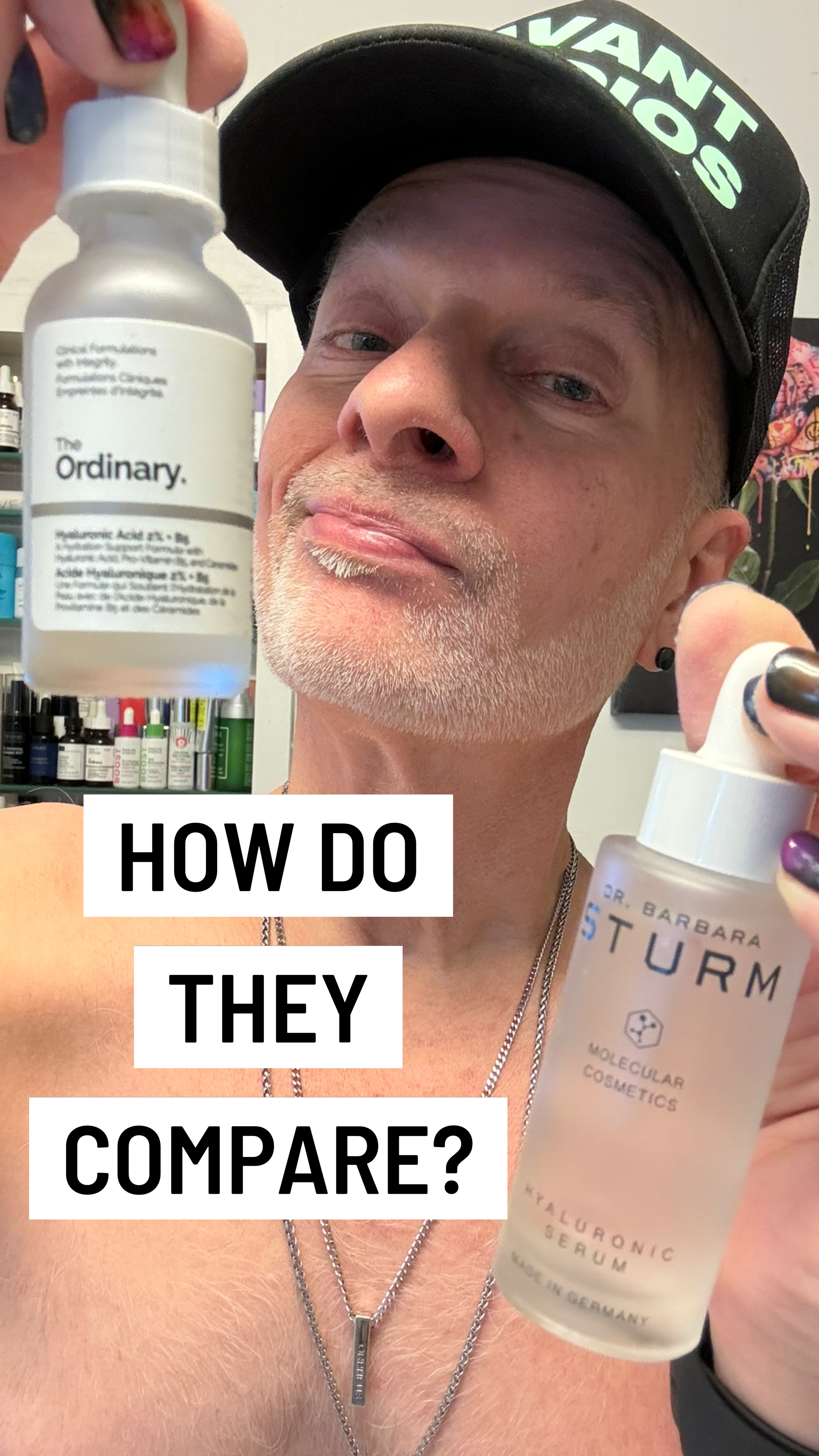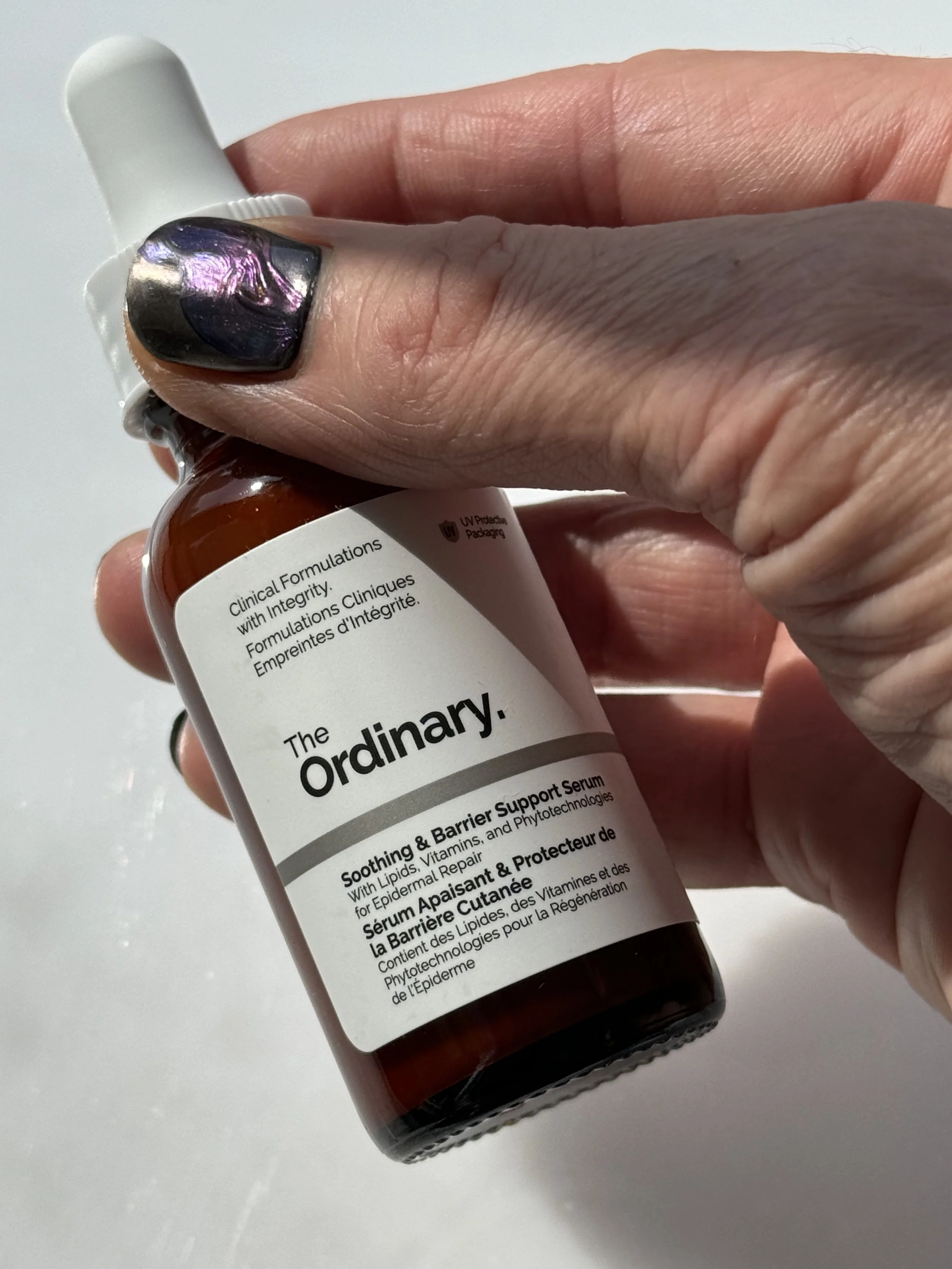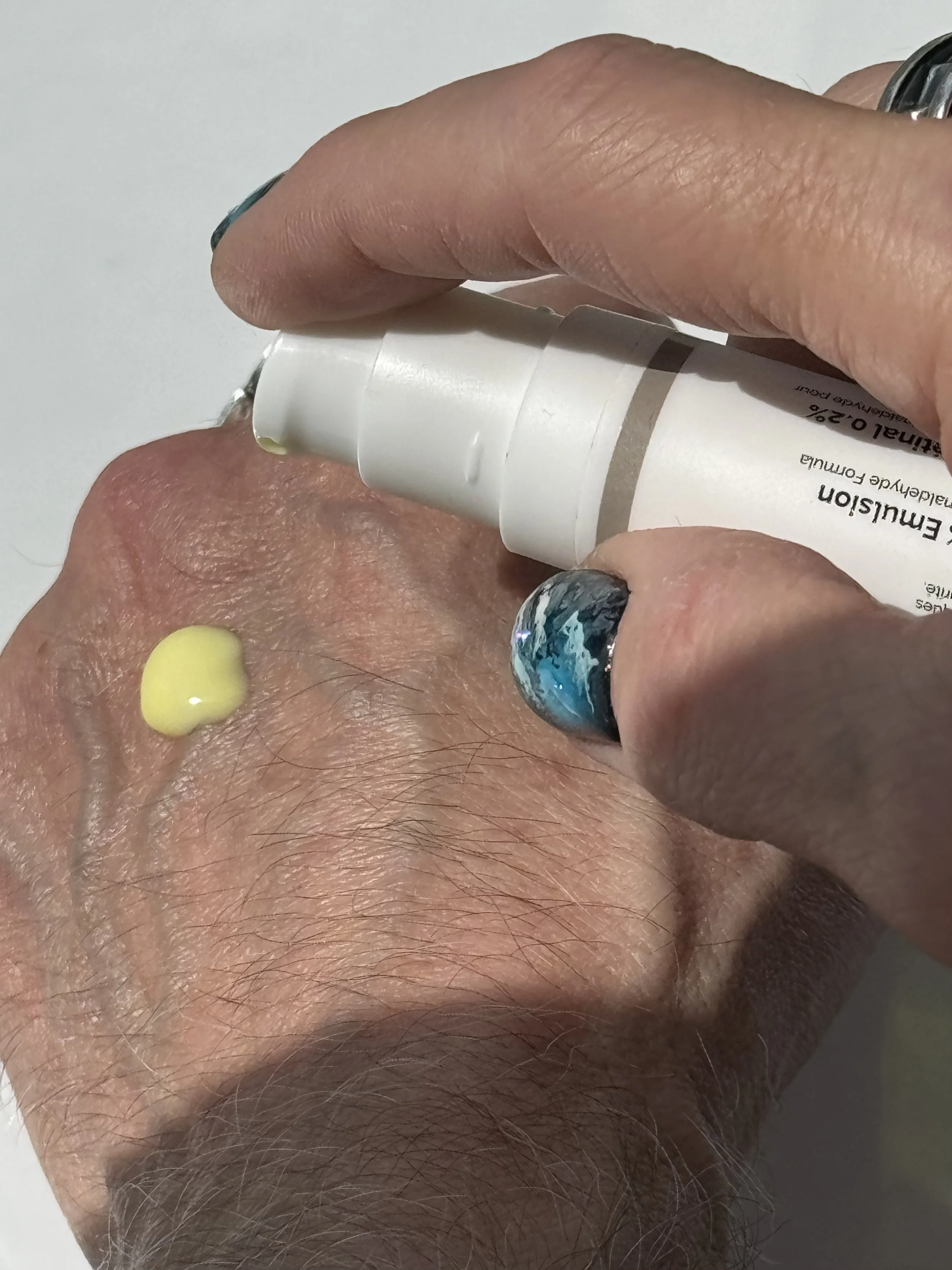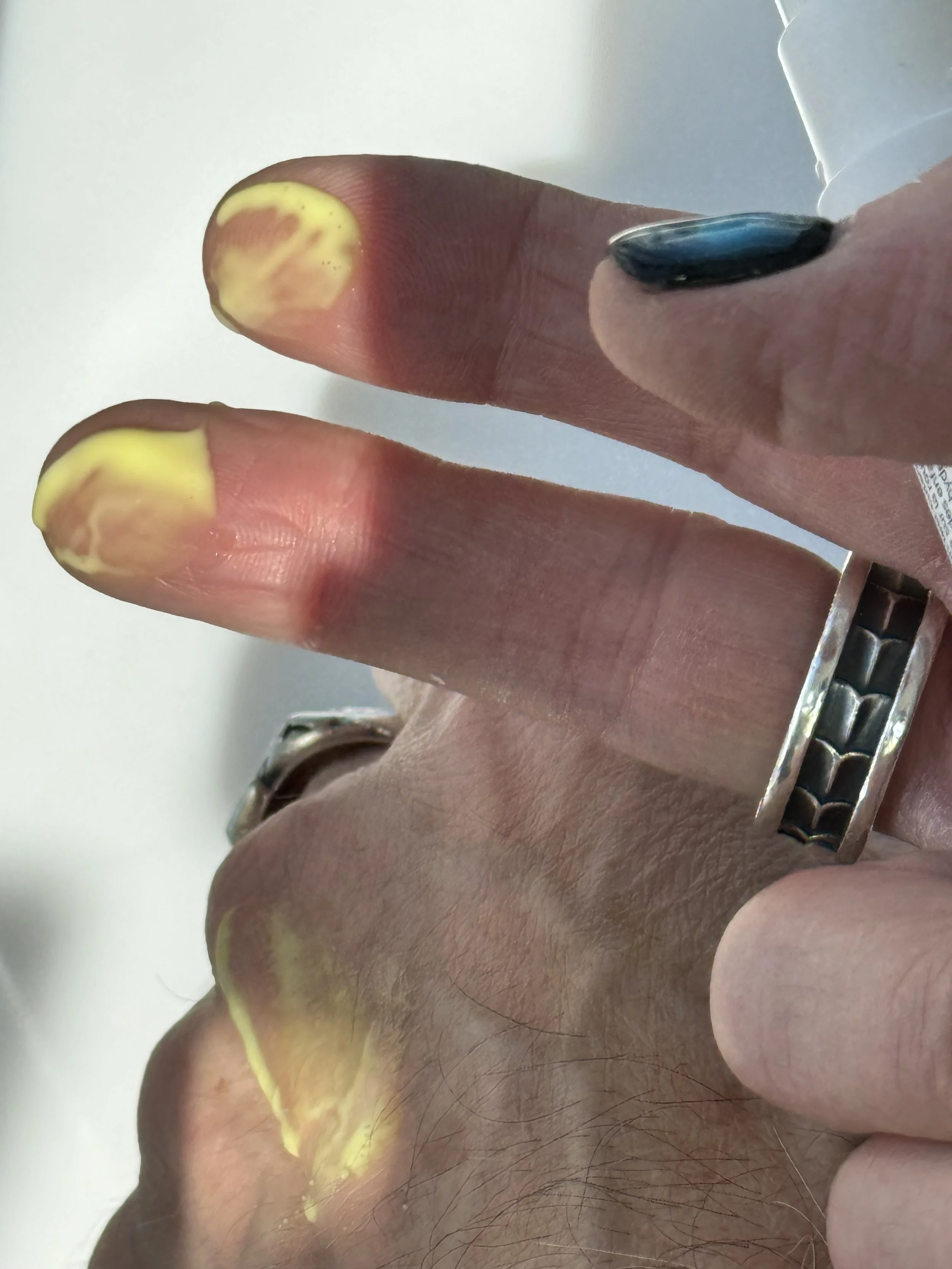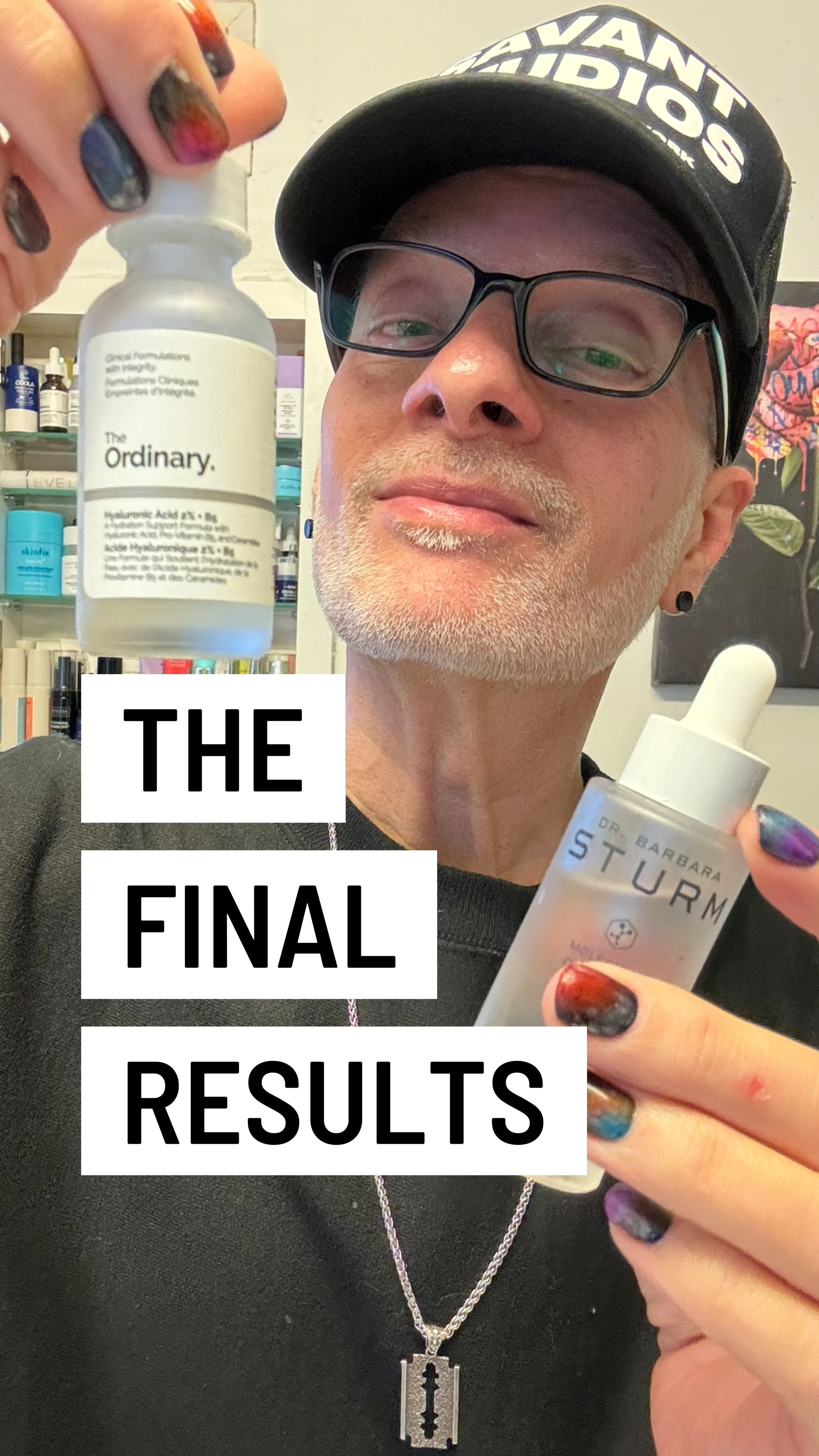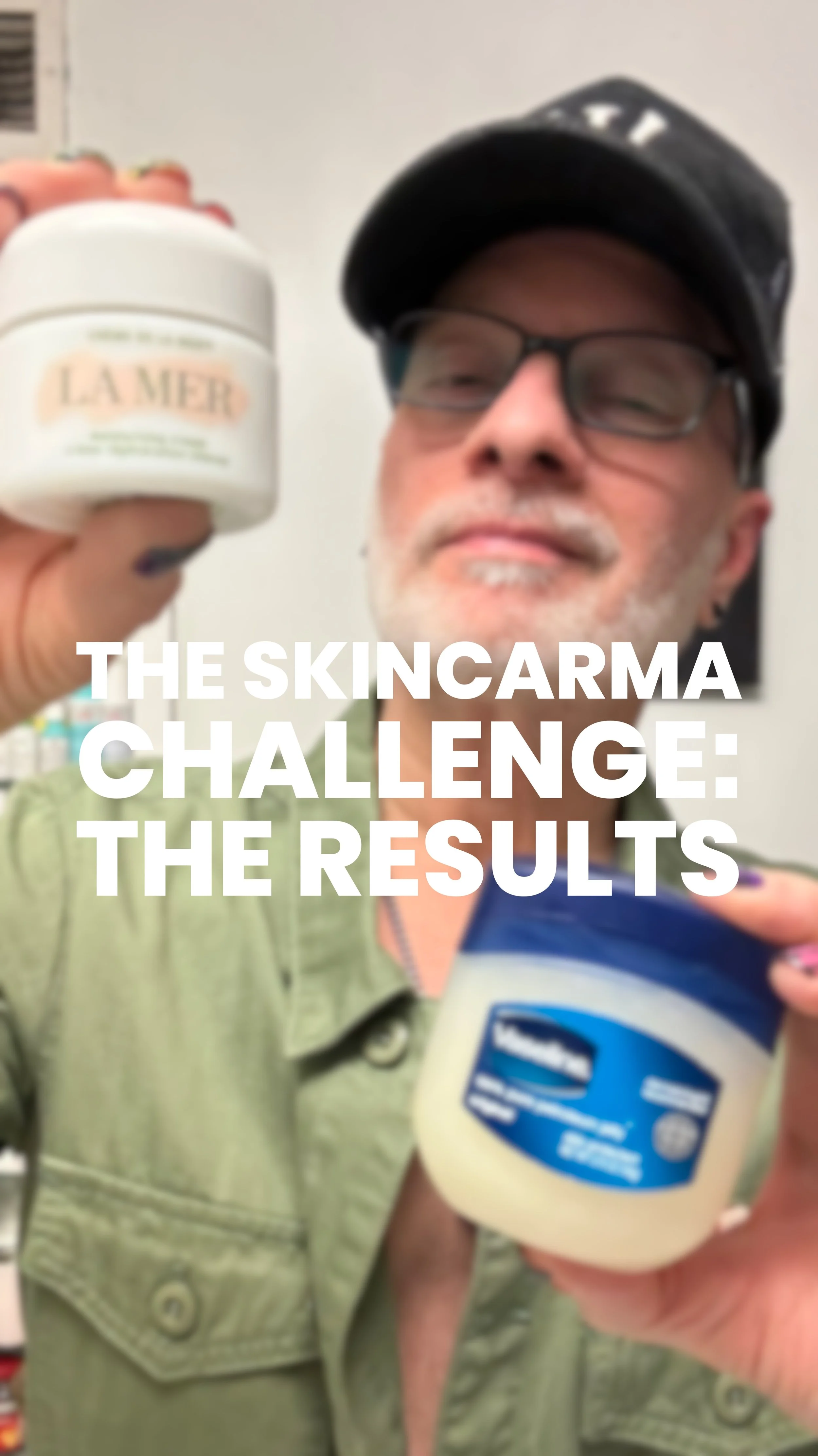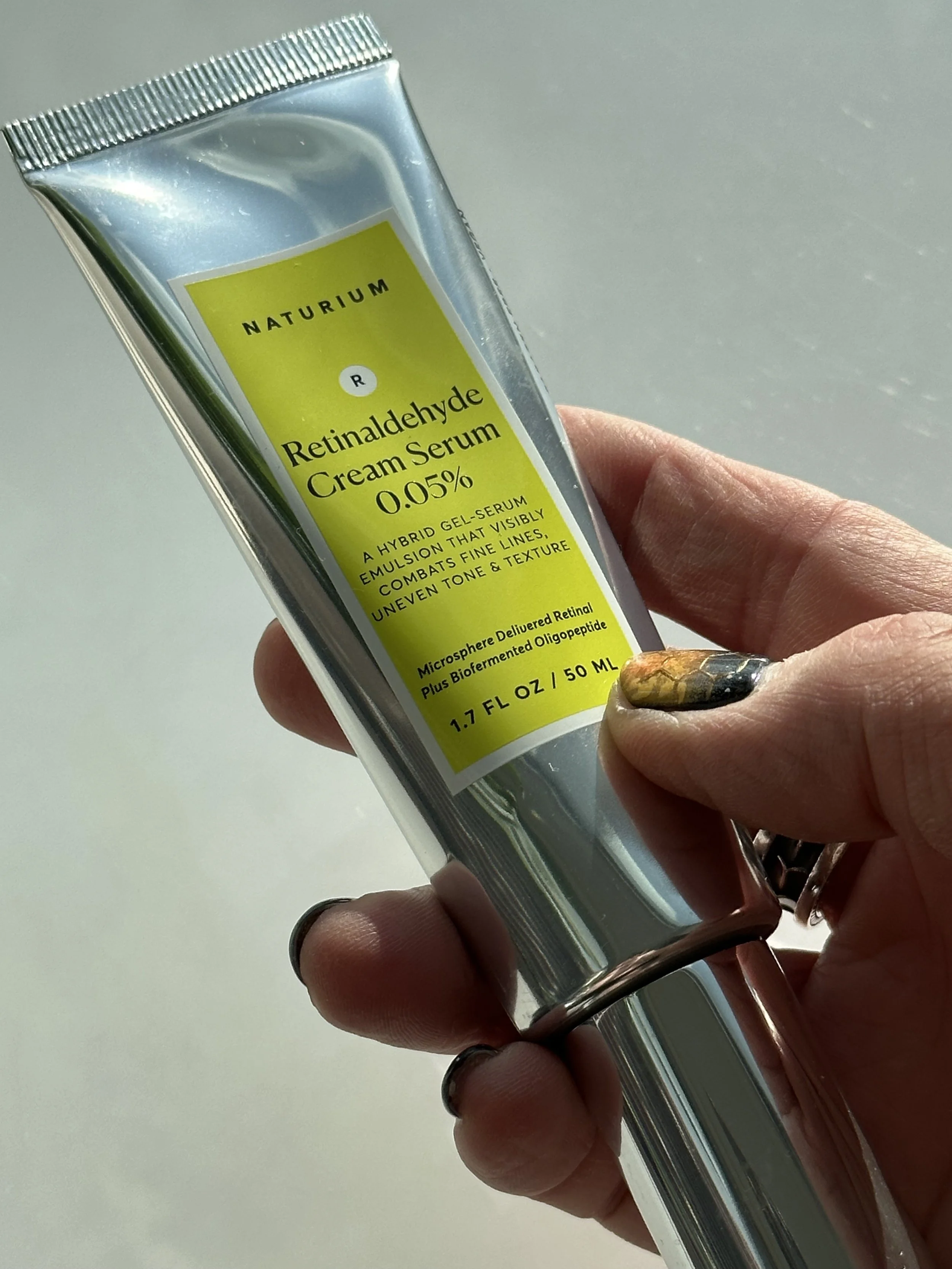PRODUCT REVIEW: THE ORDINARY RETINAL 0.2% EMULSION SERUM - What does retinol do? what is the difference between retinol and retinal? Should I use retinal or retinol?
THE ORDINARY RETINAL 0.2% EMULSION SERUM
There has been a slew of skincare innovation over the past year with what seems like 10,000 new products to target skin barrier health. And The Ordinary has certainly been a leader in innovation after a period of stagnation.
Until recently the brand hadn’t introduced anything that wowed me in ages. Sure, they launched haircare and a peptide eye lash serum. Neither interests me much – if at all.
In fact, I don’t even use shampoo! I literally use my face cleanser over my entire head in the shower each morning.
But 2023 was a breakthrough year for The Ordinary. It seems that the brand regained its footing after its absorption by the Estee Lauder corporation. That kind of thing takes time and is super disruptive.
When I moved to NYC to work for Kiehl’s in the early 2000s, the 150-year old company had been acquired by L’Oréal just six months prior. I experienced first-hand how challenging of a transition an acquisition can be on a skincare brand – especially when it comes to product launches and marketing strategy. Everything is upended.
Over the past 12 months, The Ordinary has introduced Soothing & Barrier Support Serum, several new skin type-specific facial moisturizers, and even revamped two product icons – the Hyaluronic Acid 2% + B5 and Multi-Peptide + HA Serum, formerly known as “Buffet”.
The Ordinary Retinal 0.2% Emulsion Serum is their latest innovation and first introduction of a face serum with Retinaldehyde, a more potent retinoid than Retinol. Retinaldehyde, also known as Retinal, is even more effective at treating multiple signs of aging than Retinol. More on The Ordinary’s new anti-aging face serum below…
BEST RETINOL SERUMS & FACE CREAMS
There are a select few brands that I think do a great job of addressing skin barrier health specifically – and putting that at the center of their brand identity. No brand does that more solidly than Skinfix. It’s literally at the core of the brand’s entire positioning and in all product messaging.
Of course, Paula’s Choice is among the elite skincare brands that offer products that are so well made, they can’t help but strengthen and optimize your skin barrier. But the brand doesn’t focus on skin barrier health as much as it does on key active ingredients and product innovation that support a healthy barrier.
And while The Ordinary’s marketing is similarly aligned but at more accessible pricing, the brand has been increasingly targeting barrier health with their latest innovations. The Ordinary Soothing & Barrier Support Serum as well as the new Natural Moisturizing Factors + Phytoceramides are both barrier essentials that help to easily and affordably up your skincare game.
But nothing the brand has offered to date can move the needle more than The Ordinary’s new Retinal 0.2% Emulsion Serum…
THE SKINCARMA CHALLENGE: HOW DO TWO POPULAR HA SERUMS COMPARE?
Before I get into my detailed The Ordinary Retinal 0.2% Emulsion Serum product review just below, I wanted to explore some of the most frequently asked questions about Retinal, the key ingredient technology behind the brand’s new anti-aging serum…
1. What does retinal do?
Retinal, which is short for Retinaldehyde, is a potent and active form of Vitamin A, and one of several molecules classified as retinoids. With a similar spelling and anti-aging benefits to the more commonly known Retinol, the Retinal molecule differs in its potency and conversion process in the skin.
To start, Retinal is a powerful antioxidant that fights free radical damage – like other vitamins, including Vitamin C and Vitamin B3, or Niacinamide. And while all three vitamins have anti-aging properties, retinoids like Retinal are the most effective at preventing and reversing signs of aging, including the look of fine lines, wrinkles, loss of firmness and uneven skin tone.
Retinal is the most effective OTC retinoid available without a prescription – due to its shorter conversion sequence in the skin, requiring only one conversion to retinoic acid, the most bioactive form of Vitamin A.
Retinal helps to stimulate collagen production, enhances skin elasticity, and naturally increases the production of Hyaluronic Acid within the skin, which helps to keep it more supple, hydrated and, of course, youthful looking.
In addition, Retinal has keratolytic properties that help to break down the outermost layer of the skin, stimulating desquamation and cell turnover, to freshen skin cells and smooth out a rough skin texture. This process also helps to boost skin’s reflectivity, reducing the appearance of dull, tired-looking skin.
Explore my top picks of the best Retinol creams and Retinal serums on the blog here.
Sources: Byrdie: Retinaldehyde Is the Powerhouse Retinoid Your Skin Needs; Everyday Health: Retinaldehyde 101: Benefits, Side Effects, How to Add It to Your Routine, and More
2. What is the difference between retinol and retinal?
Both Retinal and Retinol are retinoids, molecular derivatives of Vitamin A, that share structural and functional similarities. The easily confused retinoids are among the most effective anti-aging actives used in topical skincare with broad benefits for skin health and the youthful appearance of the skin.
In fact, retinoids like Retinol and Retinal are among a select few actives used in topical skincare with the ability to reverse photodamage resulting from unprotected sun exposure, including dark spots, wrinkles and loss of firmness.
However, the two molecules differ in their potency and conversion process:
Retinol is the main form of vitamin A and is actually converted into Retinaldehyde (aka Retinal) when absorbed by the skin. Retinaldehyde is then further converted to Retinoic Acid, the most bioactive form of vitamin A. Retinol is considered weaker than Retinaldehyde due to its two-step conversion process to become Retinoic Acid.
Retinaldehyde, or Retinal, is the natural precursor of Retinoic Acid and is the closest to a prescription-strength retinoid available over the counter. It requires only one conversion step to become Retinoic Acid in the skin, making it more potent than Retinol with quicker results. Due to its potency and direct conversion to Retinoic Acid, Retinal is generally considered more irritating and not a great option for sensitive skins or Retinol beginners.
Explore my top picks of the best Retinol creams and Retinal serums on the blog here.
Sources: Paula’s Choice: Retinaldehyde in Skincare; Naturium: Retinol vs Retinal: What's the Difference?
3. Should I use retinal or retinol?
The choice between Retinol and Retinal basically comes down to two factors: Is your skin sensitive and/or are you looking to step up your game?
If you’re an experienced Retinol user whose skin is already accustomed to using the potent anti-aging active, then a face serum with Retinaldehyde, or Retinal, is a great option for accelerating the benefits of retinoids.
As a regular Retinol user, you may already have seen results, e.g. existing dark spots have faded, fine lines are less visible, skin texture is smoother. Because it's likely stronger than your existing Retinol face serum, a potent Retinal serum can deliver even better results – faster.
If your skin is sensitive, Retinal is not a good option for you. Due to its quicker conversion process in the skin (see #2 above), Retinal is more likely to sensitize your skin and result in the kinds of irritation that cause people to steer clear of Retinol, e.g. redness, sun sensitivity, burning and flaking.
Explore my top picks of the best Retinol creams and Retinal serums on the blog here.
Sources: Naturium: Retinol vs Retinal: What's the Difference?; Medik8: Retinal vs Retinol: Which Is Better For Your Skin?
4. Is retinaldehyde OK for sensitive skin?
The question of whether Retinaldehyde is okay for sensitive skin isn’t entirely cut and dry. It depends on how sensitive your skin is in general and whether your skin is used to using Retinol to begin with.
As a rule, Retinaldehyde or Retinal, is not the best option for sensitive skin. Due to its quicker conversion process in the skin (see #2 above), Retinal is more likely to sensitize your skin and result in the kinds of irritation that cause people to steer clear of Retinol, e.g. redness, sun sensitivity, burning and flaking.
However, as with the more common Retinol, it’s possible for your skin to adapt to using Retinal if you start low and go slow. If you are a beginner to retinoids, you may want to consider the Cocokind Beginner Retinol Gel, which is formulated with a complex of three retinoids – .05% Retinol, .025% Retinal, and .025% Granactive Retinoid. Even less aggressive, the Naturium Retinaldehyde Cream Serum 0.05% is also a great option.
Explore my top picks of the best Retinol creams and Retinal serums on the blog here.
Sources: Arcona: The Truth About Retinaldehyde for Sensitive Skin; Byrdie: Retinaldehyde Is the Powerhouse Retinoid Your Skin Needs
5. Product Review
The Ordinary Retinal 0.2% Emulsion Serum Review
The first thing that stood out to me when I tried The Ordinary Retinal 0.2% Emulsion Serum for the first time was how unique and surprisingly elegant the texture is. I think I was expecting something lighter, with more of a serum-like quality. But then I remembered that the product is actually an emulsion.
What is an emulsion, exactly? Well, in terms of texture, emulsions are usually less dense than creams and conventional lotions, and are generally more lightweight and watery. Emulsions also tend to be less sticky, which allows them to blend better with makeup and absorb faster, with less potential to clog pores.
Because they are generally more non-comedogenic, emulsions can be a better option for those with acne-prone skin. Retinoids are great for treating acne and I would bet that The Ordinary had acne-prone skins in mind when formulating their new Retinal 0.2% Emulsion Serum.
The second point, and perhaps most important, that I want to make about The Ordinary’s new Retinal 0.2% Emulsion Serum is that it’s not for beginners – or for those with sensitive skin.
PRODUCT REVIEW: THE ORDINARY SOOTHING & BARRIER SUPPORT SERUM
In fact, the Retinal 0.2% Emulsion Serum is the brand’s most potent retinoid serum – more potent than its best-selling Retinol 1% in Squalane and Granactive Retinoid 5% in Squalane serums.
As I said in the FAQs above, Retinaldehyde, or Retinal, is more potent than Retinol due to its quicker conversion to Retinoic Acid in the skin. That speedier process means that not only is it more potent and effective, but also more sensitizing.
Fortunately, my skin is well-acclimated to retinoids and over the three weeks that I put The Ordinary Retinal 0.2% Emulsion Serum to the test, I saw no irritation or other signs of change in how my skin behaved. In other words, it worked great for me.
Formulated with 0.2% Retinaldehyde, The Ordinary Retinal 0.2% Emulsion Serum is a relatively potent formulation. My previous experiences with Retinal have been with Naturium’s Retinaldehyde Cream Serum 0.05% and Retinaldehyde Cream Serum 0.10% – both of which are milder than The Ordinary’s new Retinal face serum. Catch my reviews of each on the blog here.
BEST PRODUCTS FROM THE ORDINARY
Since it’s an “Ordinary” product, there isn’t much else going on in the formula that’s particularly notable. In addition to the Retinal itself, there are a few additional antioxidants, though they’re at far lower levels and basically insignificant for antioxidant protection.
For calming irritation, there’s also some Bisabolol, the active form of chamomile, which can help to soothe the skin. But it’s at a very low level and won’t really do much calming if you need it. If you need skin-soothing in order to use a more potent retinoid, this serum may not be right for you.
Even The Ordinary makes that clear:
“The serum-textured formula is suitable for all skin types, and is recommended for experienced users of retinoids. If you are new to using retinoids, we recommend exploring the Granactive Retinoid 2% Emulsion, or the Retinol 0.2% in Squalane, and progressing to higher strengths as your skin builds tolerance.”
In terms of application order, I’ve slotted it in as the last product in my serum step each evening after my Niacinamide and peptide serums – right before my face cream.
At just about $15 (15 mL / 0.5 oz.), The Ordinary’s Retinal 0.2% Emulsion Serum is certainly reasonably priced for the latest innovation in retinoids. It does what you hire it to do: aggressively fight multiple signs of aging. If you’re an experienced Retinol user, give it a try.
6. Pros & Cons
What I like about it: The Ordinary’s Retinal 0.2% Emulsion Serum is the most potent of the brand’s seven existing retinoid serums. I love that it’s a straight-up face serum with Retinal – the most effective retinoid available OTC. The texture is really nice – lightweight, easily layered and quickly absorbed by the skin. It’s also just about $15.
What I don’t like about it: It’s only 15 mL or 0.5 oz. – half the size of the brand’s other retinoid serums, which is somewhat deceiving. Using it 3-4x per week, I used my first one up within 14 days.
Who it’s for: All skin types.
SHOP THE BLOG: Want to try it for yourself? Purchase the The Ordinary Retinal 0.2% Emulsion Serum for $14.90 here.
FIND OUT WHICH SERUM PERFORMED BETTER – AND BY HOW MUCH!
The Ingredient List of The Ordinary Retinal 0.2% Emulsion Serum:
Aqua (Water), Coco-Caprylate/Caprate, Propanediol, Pentylene Glycol, Hydroxyapatite, Retinal, Cetylhydroxyproline Palmitamide, 4-t-Butylcyclohexanol, Hydroxyphenyl Propamidobenzoic Acid, Ergothioneine, Biosaccharide Gum-1, Bisabolol, Brassica Campestris Sterols, Zingiber Officinale Root Extract, Butylene Glycol, Isohexadecane, Hexyldecanol, Maltodextrin, Caesalpinia Spinosa Gum, Polyacrylate Crosspolymer-6, Hydroxyethyl Acrylate/Sodium Acryloyldimethyl Taurate Copolymer, Stearic Acid, Isoceteth-20, Polysorbate 60, Ascorbyl Palmitate, Tocopherol, Lactic Acid, Sodium Lactate, Sodium Hydroxide, Ethylhexylglycerin, Phenoxyethanol, Chlorphenesin.
IS IT REALLY A SCAM?
Find out on my TikTok channel.
WATCH MY VIDEO REVIEW
THE BEST NIACINAMIDE SERUMS FOR CLOGGED PORES AND A BRIGHTER COMPLEXION
ON MY YOUTUBE CHANNEL HERE
WATCH MY VIDEO REVIEW OF
SKINCARE HACKS: GLYCOLIC ACID IS THE NATURAL DEODORANT THAT WORKS!
ON MY YOUTUBE CHANNEL HERE
WATCH MY VIDEO REVIEW OF
MY FAVORITE HUMECTANT SERUMS FROM PAULA'S CHOICE, THE INKEY LIST, GHOST DEMOCRACY AND MORE
ON MY YOUTUBE CHANNEL HERE
WATCH MY VIDEO REVIEW
COOL CLEAN FACIAL SUNSCREENS TO KEEP US SAFE AND SMILING IN THE SUN!
ON MY YOUTUBE CHANNEL HERE
WATCH MY VIDEO REVIEW
THE OPULUS BEAUTY LABS RETINOL SYSTEM – THE COOLEST RETINOL INNOVATION I’VE EVER SEEN
ON MY YOUTUBE CHANNEL HERE
WATCH MY VIDEO REVIEW OF
MY WINTER SKIN SAVIOR: SKINFIX BARRIER+ LIPID REPLENISHING SKINCARE
ON MY YOUTUBE CHANNEL HERE
WATCH MY VIDEO REVIEW
A COMPLETE K-BEAUTY ROUTINE WITH THE BEST FACIAL SKINCARE FROM PURITO, COSRX, MISSHA & MORE!
ON MY YOUTUBE CHANNEL HERE
WATCH MY VIDEO REVIEW
THE YEAR’S BEST VITAMIN C SERUMS WITH PAULA'S CHOICE, SUNDAY RILEY, THE INKEY LIST AND MORE!
ON MY YOUTUBE CHANNEL HERE
WATCH MY VIDEO REVIEW OF
A SELFCARE SUNDAY NOT FOR THE FAINT OF HEART – WITH THE PAULA’S CHOICE 25% AHA PEEL!
ON MY YOUTUBE CHANNEL HERE






